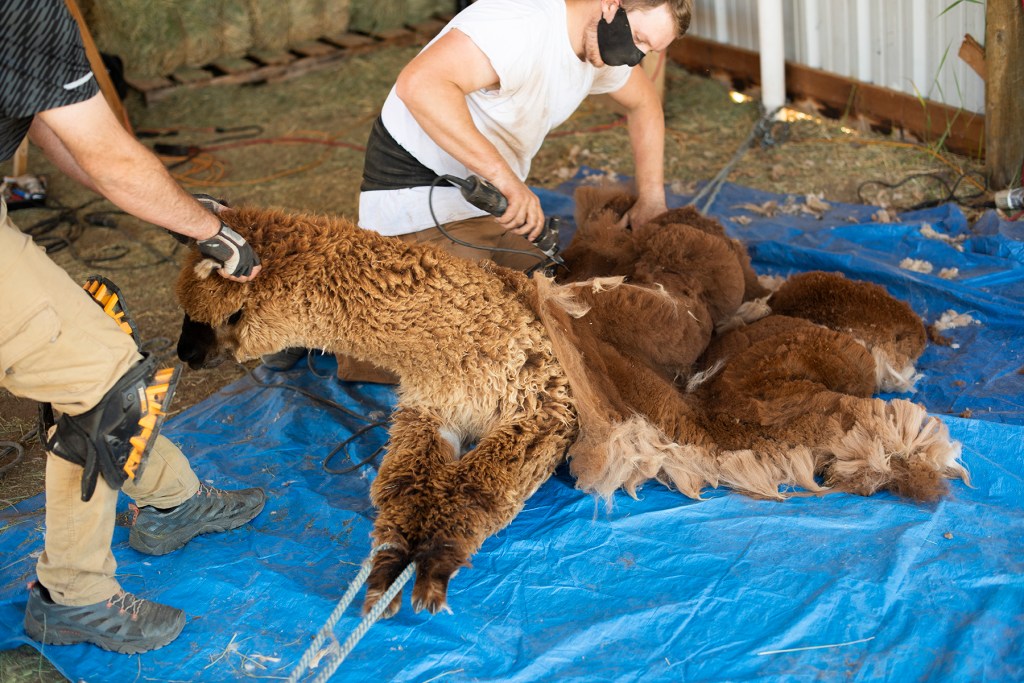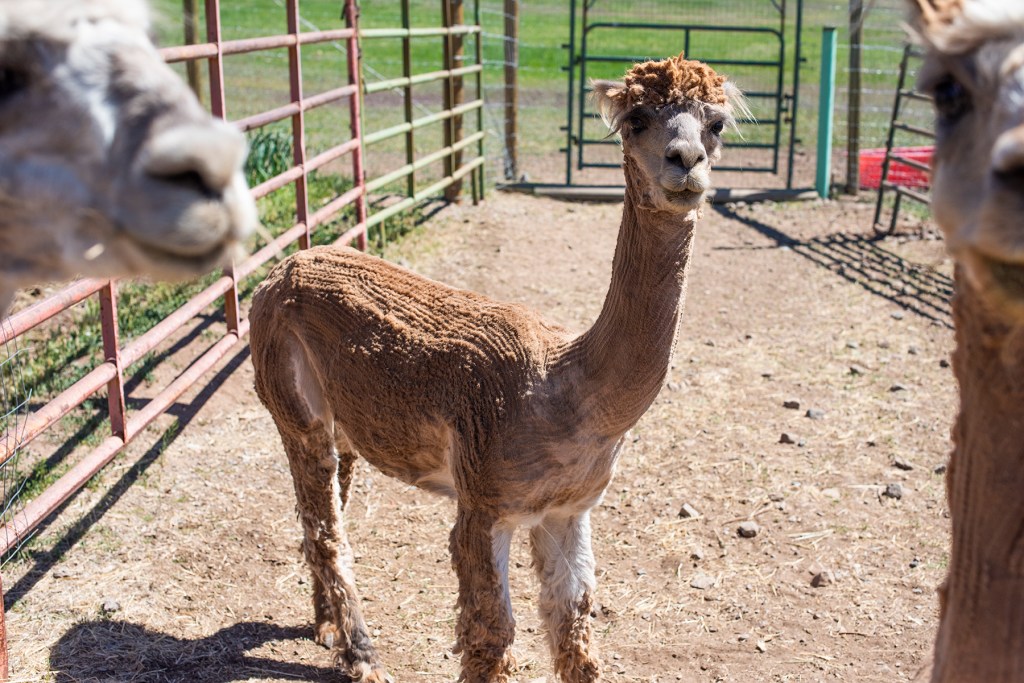
The “before” photo of the beauty makeover.
A big event happened recently at Quiet Farm: our five rescue alpacas were successfully sheared.

Yes, Paris is bleating. But please know that shearing only frightens the animals – it doesn’t hurt them.
Every spring, a shearing team makes its way across the country, traveling over thirty thousand miles in about three months. The team usually starts in early March in the southeast, where it’s already hot and humid, then heads north and west. We organized our shearing well in advance to ensure that our badly-neglected animals could be sheared this year; western Colorado was on the schedule for late May. We booked an on-farm visit so we wouldn’t need to transport our animals; the shearers also sheared groups of animals at a local vet office and other meet-up spots. Most reputable shearers won’t shear animals past the beginning of July, particularly in cold-weather climates like ours; because we adopted these animals in mid-July of last year, we missed the shearing team. We were thrilled to host them this year.

Luke shearing Paihia. On the left is all the fleece he’s removing; the animal’s flank is seen on the right.
Our shearer was the wonderfully professional and experienced Luke, whose father basically invented the alpaca-shearing technique that’s widely used across the country now. His headman, Greg, assists with all parts of the shearing, but we were very much involved too. Please note: these images might make it seem that these animals are being abused or hurt in some way. That is absolutely not the case. Although the shearing can be stressful and frightening for the animals (mostly because they’re harnessed) the shearing is not dangerous and keeps the animal far healthier, cooler and more comfortable in a hot Colorado summer.

Paihia in the beauty salon.
Our first task, before the shearers even arrived on our farm, was to safely halter the animals then attach them via a lead to one of our corral posts so the shearing could proceed swiftly. Easier said than done with our feral bunch, and you’ll notice there are no photos of that experience! We did manage to have three of five haltered before Luke and Greg arrived, but were thankful that Luke is tall and strong enough that he can actually hoist the animal onto the blue tarp you see in the photos. Once the animal is on its side, a block-and-tackle pulley harness secures the animal’s forelegs and hind legs, leaving its flanks and belly exposed. This position is indeed a bit undignified, and the alpaca doesn’t love being splayed out, but again, there’s no injury or harm done. Good shearers like Luke work quickly and efficiently to ensure that the animal is trussed for mere minutes.

The shearers are wearing masks not because of the pandemic, but because the shearing kicks up so much dust and fiber.
Our rescue animals had years’ worth of fleece growth, so the shearing took a bit longer than most. While Luke and Greg sheared, we kept the area neat and tidy, and readied things for the next animal. There was so much fleece that it was essential it was cleared away as quickly as possible so as not to interfere with the shearers’ work. The alpacas also had their toenails clipped – why not go for a pedicure too, while you’re at it? (Alpacas do not have hooves – they have two toes on each foot, with hard toenails on top and a soft pad on the bottom. This is one reason they’re so gentle on pasture, unlike cows and horses.)

Fleece of many colors.
Our five alpacas produced nearly one hundred pounds of fleece; the two males, Paris and Fiji, generated most of that. While alpaca fleece makes spectacular fiber for rugs and many other products, these poor animals were in such terrible shape that their fleece is too matted, dirty and unkempt to be of any value. We will use this fleece as mulch around trees – like an insulation sweater! – and in the compost pile. Next year, we’re likely to save the fleece for fiber work; many professional alpaca breeders keep their animals out of the pasture and have special coats to keep the fleece from becoming dirty and matted with twigs and seedheads. Our alpacas are obviously a bit more free-range, but I’d still like to experiment with spinning the fleece, if possible.

The animals look positively tiny after their shearing.
Though it’s tough to reason with a terrified alpaca when it’s being trussed for shearing, we know that the animals are so much more comfortable after losing their heavy winter coats. Would you want to wear five wool sweaters in the height of summer? We’ve noticed that they don’t immediately seek out the shade once they’re turned out into the pasture; instead, they can graze in the sun without the risk of overheating. We are so glad that the shearing went well, and we’re grateful for Luke and Greg’s professionalism and capability.
Unfortunately, two days after our successful shearing, our alpha female Kona went into unexpected labor; neither Kona nor the cria survived. This was a heartbreaking and entirely unnecessary loss and a painful reminder that when you choose to rescue animals, you take on the consequences of the abuse and neglect that happened previously. It was also a reminder that farming comes with tough lessons, and sometimes those lessons involve death. We are glad to have these funny, irascible, quirky animals on our farm, and are actively working to give them the best lives possible here.

And here’s the “after” photo of the beauty makeover.
OMG, they look so cold without their coats……I’m sure they’ll be fine! And it will grow back….thank you for sharing!
Missed you at our 1st Market,
Rick
LikeLike
Thanks for reading, Rick! The animals are definitely much more comfortable now. Hoping you have a terrific market season!
LikeLike
I’m thinking (1) they’re a few pounds lighter than before and (2) they got up, shook themselves off, and said “Yesss!”. Not that they would ever look forward to future shearing. They look much cuter!
LikeLike
Definitely many pounds lighter and much more content, Susan! But I’m certain we’ll have the same argument with them when it’s time for next year’s shearing. Thanks for reading!
LikeLike
Pingback: Farm update: July 12 | Finding Quiet Farm
Pingback: Farm update: September 20 | Finding Quiet Farm
What a wonderful read. Real life in Colorado. I had the great pleasure to try some of these folks tomatoes and peach preserves. These little gems are like being up early enough to experience a sunrise. Thank you Nicholas and Elizabeth. Paul
LikeLike
Thanks very much for your kind comment, Paul! Wishing you all the best.
LikeLike
Pingback: Farm update: October 18 | Finding Quiet Farm
Pingback: Farm update: June 6 | Finding Quiet Farm